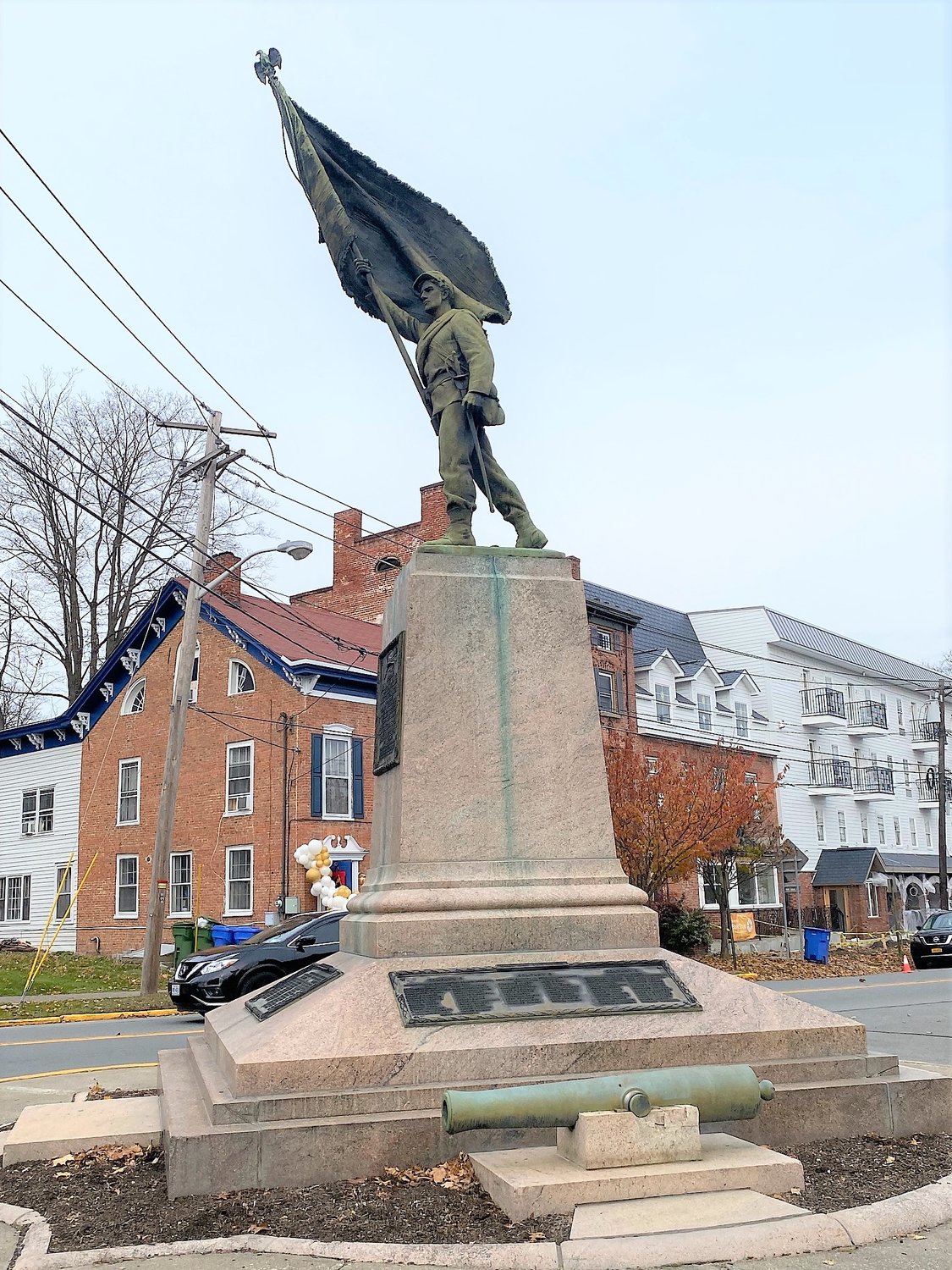
The Orange Blossoms Monument in Goshen.
By Alan B. Crawford
While continuing the cleanup at the Rossville Church and Cemetery, I happened upon a grave marker which caught my eye. First, it was that the surname was Harris, which is on a number of branches of my family tree.
Second, the individual’s, Hezakiah (different from other records) Harris, epitaph reveals he died at Gettysburg, on July 2, 1863. The inscription states he was in the Co. E Regiment of the 124th NY Volunteers.
Most of you who take a moment to read my articles know I enjoy a mystery. This one is beginning to unravel as I go down the rabbit hole. Let’s take a look.
The 124th NY Volunteers are referred to by their nickname, the Orange Blossoms. How did this come into being? In April of 1863, Colonel A. Van Horn(e) Ellis issued orange ribbons for his men to wear on their uniforms to aid them in identifying each other from other troops on the battlefield and to remind them of their home in Orange County. This was shortly before the battle of Chancellorsville in May.
Chancellorsville was a highly contested battle,with severe casualties. During this engagement, the Regiment lost Lt. Henry Gowdy, another officer and 55 of their group killed or mortally wounded. Eight of their Captains were wounded as were 135 of those under their command, with six more missing or captured.
Their mettle was truly tested at Gettysburg. In the thick of the fighting at Devil’s Den, Col. Ellis had his staff’s horses brought up. When the Colonel, Major James Cromwell, and Adjutant Henry Ramsdell mounted, a captain protested they were making targets of themselves, the Major replied “the men must see us today”.
The 124th bought an hour’s time for the Army of the Potomac’s south flank. The monument at Gettysburg is inscribed with this,
“The Orange Blossoms went into action on this spot with 18 officers and 220 men. Lost in killed and wounded 7 officers and 85 men.”
Sadly, both Colonel Ellis and Major Cromwell were killed in this action. I found a photograph of the Regiment’s battle flag, which I’ve included. One look at the flag and you understand the living hell these men walked into, again and again during the Civil War. The more I read of these heroic individuals, the more I had to know. I took the time to drift over to Goshen to view and walk around the monument erected to memorialize this Regiment and the brave individuals who made it what it was. The figure on the top of the monument is Colonel Ellis. Plaques around the monument list the individuals, including Hezekiah Harris.
It is believed when Stephen Crane was doing research for his epic, The Red Badge of Courage, he interviewed many of the survivors of the Orange Blossoms. Many believe his story is based on the Battle of Chancellorsville. If true, this may account for much of the realism in his novel.
When I viewed the plaques, both in reverence and awe, I noticed just below Hezekiah’s name is listed a Josiah Harris. Both enlisted in Company E, which was from Newburgh. Were they related? The mystery deepened, and further down the rabbit hole we went.
Beginning to dig through family trees, I found documents which began to bring Hezekiah’s life into view. There are Civil War pension papers for his widow and children, enlistment papers, and so on. What I learned is that he is my 3rd Great Grand Uncle! I’ve posted a short version of his family group with the article, but have not yet researched his descendants. I also took the time to contact various individuals who have Hezekiah on their family trees and provided them with a photo of the grave marker.
But, I began to wonder who Josiah Harris was? Another relative? I learned there was roughly a twenty year age difference between him and Hezekiah. I also learned, Josiah was buried near Chancellorsville. Curiosity is often uncontrollable, and I began ruminating on this.
Over the centuries, man developed ways to preserve bodies of their loved ones. I guess King Tut is the prime example. But, during the Civil War, men were being killed so far from home and their loved ones wanted their remains returned so they could be placed in the family plot. This is when and why the science of embalming came into wide practice! The period from 1861 is sometimes referred to as funeral period of embalming and is marked by the separation of embalming by undertakers and embalming for medical and scientific purposes.
Dr. Thomas Holmes received a commission from the Army Medical Corps to embalm the corpses of Union officers so they could be returned to their families. Private embalmers were also permitted to perform similar services under the guidance of the Army. This practice also made it available for President Lincoln’s body to be viewed for as long as it was.
So, why was Josiah interred in Virginia and Hezekiah brought home? The expense to the family? The condition of the remains after the bloody fighting at Chancellorsville? I’ve got a bunch more research to do, but wanted to share what I’ve learned so far. Perhaps, and I believe it is so, Josiah is another branch on my family tree. Thanks to all these brave men for their service!